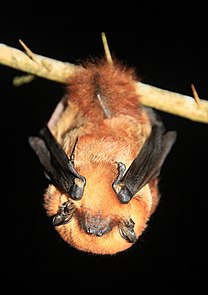
Lasiurus is a genus of bats in the family Vespertilionidae. Its members are known as hairy-tailed bats or red bats.

The desert red bat, also known as the western red bat or southern red bat is a species of microbat found across the Americas. Lasiurus blossevillii is most often found in tree foliage, as is most in the genus Lasiurus, and is a solitary species.

The hoary bat is a species of bat in the vesper bat family, Vespertilionidae. It lives throughout most of North America and much of South America, with disjunct populations in the Galápagos Islands and Hawaii.
The hairy-tailed bat, is a bat species originally known only from its type locality, Ilha do Cardoso State Park in Brazil. A second specimen was collected in 2018, in Carlos Botelho State Park, approximately 100 kilometers away.

The big red bat is a species of vesper bat from South and Central America.

The eastern red bat is a species of microbat in the family Vespertilionidae. Eastern red bats are widespread across eastern North America, with additional records in Bermuda.
The Tacarcuna bat is a species of vesper bat. It is found in Costa Rica, Panama and possibly Colombia.

The Seminole bat is a species of bat in the family Vespertilionidae.

The western yellow bat is a species of vesper bat. It is found in Mexico and the southwestern United States. This species roosts in trees such as Populus fremontii, Platanus wrightii, and Quercus arizonica. If available, the western yellow bat will use the dead fronds that encircle palm trees as a roosting site.

The northern yellow bat is a non-migratory bat in the family Vespertilionidae, typically active year-round except during abnormally frigid winter weather, during which they will induce torpor.

The silver-haired bat is a solitary migratory species of vesper bat in the family Vespertilionidae and the only member of the genus Lasionycteris.
The Jamaican red bat is a species of vesper bat. It is endemic to Jamaica.

The cinnamon red bat is a species of bat in the family Vespertilionidae. It was first described from a specimen that had been collected in Chile. For more than one hundred years after its initial description, it was largely considered a synonym of the eastern red bat. From the 1980s onward, it was frequently recognized as distinct from the eastern red bat due to its fur coloration and differences in range. It has deep red fur, lacking white "frosting" on the tips of individual hairs seen in other members of Lasiurus. It has a forearm length of 39–42 mm (1.5–1.7 in) and a weight of 9.5–11.0 g (0.34–0.39 oz).
The Cuban yellow bat is a species of bat from the family Vespertilioninae. It was previously included as a subspecies of the northern yellow bat, a species that has a similar ecology and biology. The species is endemic to Cuba, specifically the Las Villas Province in Cienfuegos, and it is listed under the IUCN Red List as vulnerable due to its ongoing population reduction and relatively small geographic range.
The minor red bat is a species of bat from the family Vespertilioninae. It is found in the Bahamas, Dominican Republic, Haiti, and Puerto Rico, though there are only six known individuals in the latter. Hurricanes, habitat destruction, and human population growth are several factors leading to a decreasing population trend, and the minor red bat is listed as vulnerable by the IUCN Red List due to ongoing population reduction and a small geographic range. The minor red bat is a solitary, insectivorous species that forages in open areas and rests among the leaves of a tree. It is a swift flier, though it is not highly maneuverable. The minor red bat is possibly conspecific with the Seminole bat, Eastern red bat, and Desert red bat.
Pfeiffer's red bat is a species of bat from the family Vespertilioninae and is endemic to Cuba. It is listed as Near Threatened by the IUCN Red List due to a significant population decline, caused by human population density on its endemic island, habitat conversion, and hurricanes. The species is likely insectivorous; fecal matter samples from a single bat contained only beetles. It may be a subspecies of the Seminole bat.

The saline red bat is a species of bat from the family Vespertilionidae. It was formerly included as a subspecies or a synonym of the eastern red bat and the desert red bat, but is distinct. The species is present in Argentina, and its type locality has been found in the city of Cruz del Eje in the Córdoba Province.
The western red bat is a species of microbat in the family Vespertilionidae. Previously, it was believed to be a subspecies of Lasiurus blossevillii, and was called Lasiurus blossevillii teliotis.












